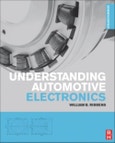Understanding Automotive Electronics is the first port of call for control engineers, system engineers and electronic engineers in the automotive industry needing a thorough grounding in automotive electronics and control.
From simple automotive electronic circuits to the latest developments in telematics, active safety, entertainment and communications, the book is also an ideal resource for more senior automotive engineers without a background in electronics or control needing to work in the area or supervise specialists.
Thoroughly updated throughout, this new edition moves away from introductory mechanic-level electronics to cover more hot topics such as transmission control, hybrid control, AUTOSAR (AUTomotive Open System ARchitecture) and vehicle networks.
Please Note: This is an On Demand product, delivery may take up to 11 working days after payment has been received.
Table of Contents
1. Automotive Fundamentals 2. The Systems Approach to Control and Instrumentation 3. Electronics Fundamentals 4. Microcomputer Instrumentation and Control 5. The Basics of Electronic Engine Control 6. Sensors and Actuators 7. Digital Engine Control Systems 8. Vehicle Motion Control 9. Automotive Instrumentation and Telematics 10. Diagnostics








